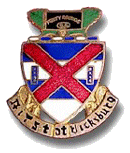(8th INFANTRY DIVISION) IN THE ATTACK ON DÜREN, GERMANY,
AFTER THE CROSSING OF THE ROER RIVER,
23 - 25 FEBRUARY 1945
(RHINELAND CAMPAIGN)
By Captain Alexander F. Berol

INTRODUCTION
This monograph covers the operations of Company L, 13th Infantry, 8th U. S. Division in the attack on Düren, Germany after the crossing of the ROER RIVER, 23-25 February 1945.
In order to provide an orientation, it is necessary to briefly discuss the events prior to this action.
The 8th U.S. Division prior to 7 February had had a holding mission along the west bank of the ROER RIVER, in the vicinity of the HÜRTGEN FOREST, GERMANY. 1 On 7 February the 8th U.S. Division, pursuant to orders from VII Corps, was relieved by the First U.S. Division and given the mission of relieving elements of the 104th U.S. Division on the west bank of the ROER RIVER in the vicinity of DÜREN. 2
THE GENERAL SITUATION
The 13th Infantry relieved the 414th Infantry, 104th U.S. Division in the vicinity of GÜRZENICH, RÖLSDORF and DERICHSWEILER with the mission of preparing for crossing the ROER RIVER, and seizing the city of DÜREN, and the Corps bridgehead on or about 14 February 1945. 3 The plans for a jump off on 14 February were abruptly altered on 9 February when the Germans opened the gates of the SCHWAMMENAUEL DAM to the south or towards the source of the ROER RIVER. 4 This created an impassable barrier, in the 13th Infantry sector, as the ROER RIVER which had been fordable was now a raging torrent, approximately 10 to 15 feet deep, with a current speed of 10 to 15 miles per hour. 5 The creation of this man made barrier, while postponing the scheduled attack, gave all U.S. units an opportunity for development and practice in the art of river crossing, an opportunity to continue the build up of supplies and equipment, an opportunity to further train any new replacements and most important of all, an opportunity for detailed study of maps and the latest aerial photographs, as well as daylight visual reconnaissance of the western portion of DÜREN. 6
Supplies and equipment to include supporting units were poured into this area so that the general area of DERICHSWEILER-GÜRZENICH resembled a rear area supply point rather than a reserve battalion sector, all within mortar range of the enemy. 7
Training in river crossings took place, however the practice was on a small almost still-water creek. The equipment used was standard engineer assault boats operated by engineer personnel. 8
Intensive study of all maps and aerial photographs was done by all personnel down to and including squad leaders.
Visual reconnaissance over a large sector of DÜREN was made by all personnel. 9

The 13th Infantry was, as were all units in this general sector, committed, yet awaiting the drop in the ROER RIVER. It had the 1st Battalion deployed in defensive positions in the town of RÖLSDORF, along the western banks of the ROER RIVER. The 2d and 3d Battalions were in DERICHSWEILER and GÜRZENICH respectively in assembly areas awaiting "jump off" day. This regiment had the 104th U.S. Division on the left and the 28th Infantry of its own division on the right. 10
The 3d Battalion was billeted in the town of GÜRZENICH with no tactical formation as use was being made of suitable quarters along the one large main street of this town. L Company, the to be reserve company of the attack, was well set up in the most comfortable quarters to be found in its section of town.
The plan for the 13th Infantry was for the 2d and 3d Battalions to attack abreast through the 1st Battalion with the 2d Battalion on the right and the 3d Battalion on the left. 11
The 13th Infantry was opposed by elements of the 12th Volksgrenadiers, the 353d Infantry Division and the 363d Infantry Division. 12
The combat efficiency and Esprit de Corps were very high, as all troops were rested, well trained, fully equipped and rearing to go. During the period of waiting for the ROER RIVER to recede to normal the only combat realized was some light mortar fire as well as propaganda leaflets issuing the 8th U.S. Division an invitation to attempt the river crossing. These rather than cause any alarm brought to mind "how did the Germans know who was waiting to cross" plus a feeling of slight amusement. 13
The enemy was well set defensively although the number of troops apparently was not too great. It is believed their morale and efficiency was high as they had their river, in addition to a well dug-in set of defensive positions, protected by minefields.
The terrain on both sides of the river was similar, flat with good footing, as the spring thaw was about over and the ground had partially dried out. However, armor, if and when used would be required to stay on roads. The enemy had the advantage of a more built up area, and a slight advantage of long range observation as the eastern side of DÜREN was the commanding ground in this area. The weather was fair with visibility well over 3000 yards although generally overcast skies. 14
Logistical support for the offensive was excellent, despite the heavy mud in the roads as well as heavy rains in early February. The improved weather after 15 February assisted with the logistical problem so that no items were in short supply. The enemy supply situation was known to be poor due to our Air Force constantly bombing their supply dumps, road nets and key railroad yards. This bombing as well as straffing further reduced the number of motor vehicles they could muster to support any operation. 15

